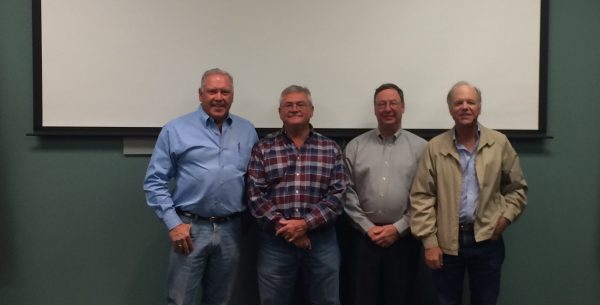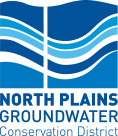GMA 1 Approves Desired Future Conditions for Panhandle Counties
The four-member committee in charge of planning for the Panhandle’s future groundwater needs approved goals that will affect water policy in the area for the next 50 years. The Groundwater Management Area 1 (GMA 1) Joint Planning Committee (JPC), comprised of a representative from the four groundwater conservation districts within GMA 1 and one at-large member, approved a resolution at their November 2nd meeting that establishes Desired Future Conditions (DFCs) for the 18 counties in GMA 1. A DFC is a goal for the volume of water to be left in the aquifer at a specific point in the future. The approval is the culmination of a three-year process that included joint planning between the districts, public meetings across the districts, and public comment periods for citizens to have input into the process.
 Voting members of GMA 1 (left to right) Bob Zimmer, Danny Hardcastle, Lynn Tate, and Jim Haley.
Voting members of GMA 1 (left to right) Bob Zimmer, Danny Hardcastle, Lynn Tate, and Jim Haley.
“We appreciate the commitment of all involved in the process to insure we are doing our best to be good stewards of the resource today and planning for the future quality of life of all citizens of the region,” said Bob Zimmer, North Plains Groundwater Conservation District (NPGCD) board president and chairman of the JPC. Danny Krienke, NPGCD Director for Ochiltree County and Secretary of the NPGCD board, serves as the GMA 1 representative on the Panhandle Regional Water Planning Group. GMA 1 is made up of all or part of the following groundwater conservation districts: Hemphill County Underground Water Conservation District (HCUWCD), High Plains Underground Water Conservation District (HPUWCD), NPGCD and Panhandle Groundwater Conservation District (PGCD).
A resolution of adoption of the DFCs, along with the explanatory report detailing the consideration process, will be sent to the Texas Water Development Board (TWDB) for review. TWDB staff will check to insure that legal and administrative procedures were followed throughout the creation of the DFCs. Once approved by the TWDB, and barring any protest by an affected party, the DFCs will take effect.
According the Texas Water Code, the JPC was charged to adopt DFCs that will “…provide a balance between the highest practicable level of groundwater production and the conservation, preservation, protection, recharging, and prevention of waste of groundwater in the management area.”
The DFCs approved by the JPC are as follows:
- At least 40 percent of volume in storage remaining in 50 years, for the period 2012 – 2062 collectively in Dallam, Hartley, Moore, and Sherman Counties;
- At least 50 percent of volume in storage remaining in 50 years, for the period 2012 – 2062 collectively in Hansford, Lipscomb, and Ochiltree Counties and that portion of Hutchinson County within NPGCD.
- At least 50 percent of volume in storage remaining in 50 years, for the period 2012 – 2062 in Carson, Donley, Gray, Hutchinson, Oldham, Roberts, and Wheeler Counties; and portions of Armstrong and Potter Counties within the PGCD;
- At least 80 percent of volume in storage remaining in 50 years for the period 2012 – 2062, within the HCUWCD;
- Approximately 20 feet of total average drawdown in 50 years for the period 2012 – 2062, collectively in Randall County and in Armstrong and Potter Counties within the HPUWCD.
The JPC adopted the following DFCs for the Dockum Aquifer in the GMA 1 Joint Planning Area:
- At least 40 percent of the available drawdown remaining in 50 years for the period 2012 -2062 collectively for Dallam, Hartley, Moore, and Sherman Counties.
- No more than 30 feet average decline in water levels in 50 years for the period 2012 -2062 collectively in Carson and Oldham Counties and in Armstrong and Potter Counties within the PGCD; and
- The total average drawdown is approximately 40 feet in 50 years for the period 2012 -2062, collectively in Randall County, and in Armstrong and Potter Counties within the HPUWCD.
The JPC designated the Blaine Aquifer in Wheeler County as non-relevant for the purposes of joint planning.
In the process of establishing DFCs, the JPC was required to consider the following factors listed in Texas Water Code Section 36.108(d)(1 – 9):
- aquifer uses or conditions within the management area, including conditions that differ substantially from one geographic area to another;
- the water supply needs and water management strategies included in the state water plan;
- hydrological conditions, including for each aquifer in the management area the total estimated recoverable storage as provided by the TWDB Executive Administrator and the average annual recharge, inflows, and discharge;
- other environmental impacts, including impacts on spring flow and other interactions between groundwater and surface water;
- the impact of subsidence;
- socioeconomic impacts reasonably expected to occur;
- the impact on the interests and rights in private property, including ownership and the rights of management area landowners and their lessees and assigns in groundwater as recognized under Texas Water Code Section002;
- the feasibility of achieving the DFCs; and
- any other information relevant to the specific DFCs;
All supporting documents for the DFC planning and adoption process are available to the public at www.panhandlewater.org.
For more information contact Kirk Welch at kwelch@northplainsgcd.org or 806-922-7947.
